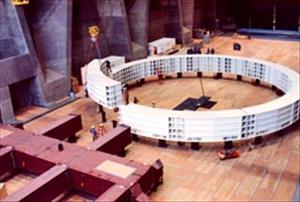On June 14, 1966, President Lyndon B. Johnson (1908-1973) signs a bill authorizing the construction of a third powerhouse at Grand Coulee Dam on the Columbia River in Central Washington. The new powerhouse, completed in 1980, will double the dam's generating capacity.
Power generation was initially intended to be only a secondary purpose of Grand Coulee Dam, which was designed by the Bureau of Reclamation in the 1920s as part of a massive irrigation project. The focus shifted in response to demands for electricity during World War II. The dam was built with two huge power plants, each designed to accommodate nine 108,000-kilowatt generators -- at the time the largest in the world. The first of the generators went on line in October 1941; eight additional units were in service by the end of the war.
Even before the last of the original generators was installed, in September 1951, Bureau of Reclamation officials began considering the possibility of adding a third power plant. Cold War rivalries accelerated that effort. With the completion of the Kuibyshev dam on the Volga River in 1955, the Soviet Union bumped Grand Coulee from its position as the greatest hydroelectric plant in the world. To add insult to injury, by 1958, the Soviets had three other dams that could out-produce Grand Coulee.
One problem was that there were no more sites on the main stem of the Columbia River within the United States where water could be stored for release when needed to feed any new generators at Grand Coulee. Senator Warren G. Magnuson (1905-1989), a Democrat from Seattle and a powerhouse of his own in Washington, D.C., played a key role in securing the complicated agreements that led to the construction of five new dams on the Columbia in Canada in the 1960s and early 1970s. By regulating the flow of the river, these dams made it possible to expand the generating capacity at Grand Coulee.
The Senate approved construction of the third powerhouse on June 16, 1965, but political maneuvering delayed final action on the bill for a year. Construction began in early 1967.
The original design for the powerhouse called for the installation of 12 generators, each producing 300,000 kilowatts. Secretary of the Interior Stewart L. Udall (b. 1920) ordered that 600,000-kilowatt generators be used instead. At the time, no American manufacturer was building generators that large. The Soviet Union, however, had equipped several of its dams with 500,000-kilowatt units, and offered to bid for the contract to build the generators for Grand Coulee. "It is an understatement to say that the inquiry panicked the bureaucrats," as historian Paul C. Pitzer put it. "If the Russians won the bid and built the units, they could still claim at least a part in the world's largest power plant. That would cloud Grand Coulee's glory when it reclaimed the title as the world's biggest. In propaganda terms, the Soviets seized a wonderful opportunity to embarrass the United States" (Pitzer, 343).
The Interior Department soon announced that only domestic bids would be accepted. It also implemented a "Buy American" policy, requiring that at least 51 percent of the components in the generators be manufactured in the United States. This, too, created difficulties. Both General Electric and the Westinghouse Corporation -- the only American companies with the expertise to manufacture the generators -- relied heavily on parts from Japan, Canada, and Sweden.
Delays in constructing the powerhouse led to delays in the call for bids on the generators. By 1973, when the contracts were ready for bid, the issue had faded. Westinghouse built the first three units. The contract for the next three units -- behemoths of 700,000 kilowatts each -- was awarded to the Canadian General Electric Company.
The first new generator went on line in October 1975; the sixth began operating on April 1, 1980, making Grand Coulee once again the world's largest hydroelectric plant. To further increase power output, the capacity of the original 18 generators was increased from 108,000 kilowatts to 125,000. In the late 1990s, the three 700,000-kilowatt units in the third powerhouse also were upgraded, to 805,000 kilowatts. As of 2005, Grand Coulee still produces more electricity than any other dam in the United States, but it has been eclipsed internationally by two dams in China.
Three years after authorizing construction of the third powerhouse at Grand Coulee, Johnson signed the National Environmental Policy Act into law. Partly as a result of provisions in that law, the powerhouse remains only half finished -- with six instead of the originally planned 12 giant generators. Efforts to mitigate the impact of power generation on endangered salmon and steelhead in the Columbia make it unlikely that the additional generators will ever be installed.

